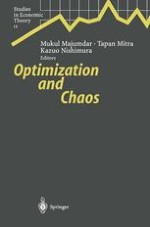2000 | OriginalPaper | Buchkapitel
Ergodic Chaos in Optimal Growth Models with Low Discount Rates
verfasst von : Kazuo Nishimura, Gerhard Sorger, Makoto Yano
Erschienen in: Optimization and Chaos
Verlag: Springer Berlin Heidelberg
Enthalten in: Professional Book Archive
Aktivieren Sie unsere intelligente Suche, um passende Fachinhalte oder Patente zu finden.
Wählen Sie Textabschnitte aus um mit Künstlicher Intelligenz passenden Patente zu finden. powered by
Markieren Sie Textabschnitte, um KI-gestützt weitere passende Inhalte zu finden. powered by
Whether or not erratic economic behavior can be explained by models of infinitely-lived rational agents has been discussed in the economic literature for some years. A positive answer to this question was provided first by Deneckere and Pelikan (1986) and Boldrin and Montrucchio (1986); that is, optimal paths of capital accumulation may behave chaotically. Until recently, however, the possibility of chaotic optimal dynamics has been established only for the case in which future utilities are discounted extremely heavily. This fact is in line with the intuition obtained from the turnpike literature, namely, that weak myopia tends to simplify the dynamic behavior of optimal growth paths (see, e.g, Brock and Scheinkman (1976), Cass and Shell (1976), McKenzie (1976, 1983), Scheinkman (1976), Yano (1990)). In Sorger (1992a,b, 1995) this intuition is further strengthened by the minimum impatience theorems which demonstrate that for any given dynamical system generating complicated dynamics there is an upper bound for the set of those discount factors with which that system is the optimal policy function of an optimal growth model. These results, however, do not exclude the possibility of chaotic optimal dynamics for arbitrary low myopia.
